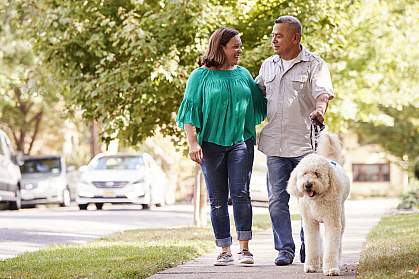You are here
March 19, 2019
Getting active later in life brings benefits
At a Glance
- People who were inactive as teens and young adults but increased physical activity in middle age saw the same reduced risk of death as those who stayed active from adolescence onward.
- These results add to evidence that becoming active later in life can provide substantial health benefits.

Physical activity reduces the risk of many chronic illnesses and increases the odds of a longer, healthier life. But it hasn’t been clear whether the benefits of exercise differ based on when during their lives people are most active.
Researchers led by Dr. Pedro Saint-Maurice from NIH’s National Cancer Institute (NCI) wanted to examine this question in more detail. They looked at data collected from more than 300,000 Americans who participated in the NIH-AARP Diet and Health Study.
People aged 50 to 71 were invited to join the study in the mid-1990s. They filled out surveys that categorized their physical activity levels during different life stages: in adolescence, in their 20s and 30s, and during the 10 years before they joined the study. The study tracked participants through 2011 for deaths from any cause as well as deaths specifically from heart disease or cancer.
Saint-Maurice and his team grouped participants into categories based on the physical activity survey data and looked for differences in survival between these groups. The researchers adjusted their analyses to account for influences from people’s existing health problems. Results were published on March 8, 2019, in JAMA Network Open.
People who were active during adolescence but not later in life gained little benefit compared to people who were never active. Those who exercised for at least 2 hours a week throughout their life were about a third less likely to die during the study than people who were never active.
Unexpectedly, people who stopped exercising in their 20s and 30s but picked the habit up again later (40-61 years of age) seemed to benefit just as much as people who maintained activity across their lifespan. They had similar reductions in the risk of dying from heart disease, cancer, or any cause during the study.
These benefits were seen in both men and women, and regardless of participants’ body mass index (or BMI, a ratio of weight to height) during the study.
“Midlife is not too late to start being active,” Saint-Maurice says. “People who have been physically inactive throughout much of their adulthood can gain substantial health benefits by increasing their physical activity.”
Participants in the study were mostly white and highly educated. Future studies are needed to see if these findings hold up in ethnically and economically diverse populations.
—by Sharon Reynolds
Related Links
- Light Activity May Lower Harmful Effects of Sitting
- Physical Activity Associated with Lower Risk of Many Cancers
- Physical Activity May Reduce Age-Related Movement Problems
- Physical Activity Program Helps Maintain Mobility
- A Little Exercise Might Lengthen Life
- Exercise and Physical Activity
References: Association of Leisure-Time Physical Activity Across the Adult Life Course With All-Cause and Cause-Specific Mortality. Saint-Maurice PF, Coughlan D, Kelly SP, Keadle SK, Cook MB, Carlson SA, Fulton JE, Matthews CE. JAMA Netw Open. 2019 Mar 1;2(3):e190355. doi: 10.1001/jamanetworkopen.2019.0355. PMID:30848809.
Funding: NIH’s National Cancer Institute; Fundacao para a Ciencia e Tecnologia.
